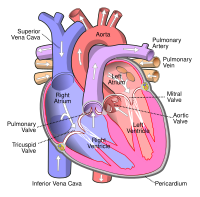
Photo from wikipedia
Heart sound analysis has been a major topic of research over the past few decades. However, the necessity for a large and reliable database has been a major concern in… Click to show full abstract
Heart sound analysis has been a major topic of research over the past few decades. However, the necessity for a large and reliable database has been a major concern in these studies. OBJECTIVE Noting that the current heart sound classification methods do not work properly for noisy signals, the PhysioNet/CinC Challenge 2016 aims to develop the heart sound classification algorithms by providing a global open database for challengers. This paper addresses the problem of heart sound classification methods within noisy real-world phonocardiogram recordings by implementing an innovative approach. SIGNIFICANCE After locating the fundamental heart sounds and the systolic and diastolic components, a novel method named cycle quality assessment is applied to each recording. The presented method detects those cycles which are less affected by noise and better segmented by the use of two criteria here proposed in this paper. The selected cycles are the inputs of a further feature extraction process. APPROACH Due to the variability of the heart sound signal induced by various cardiac arrhythmias, four sets of features from the time, time-frequency and perceptual domains are extracted. Before starting the main classification process, the obtained 90-dimensional feature vector is mapped to a new feature space to pre-detect normal recordings by applying a Fisher's discriminant analysis. The main classification procedure is then done based on three feed-forward neural networks and a voting system among classifiers. MAIN RESULTS The presented method is evaluated using the training and hidden test sets of the PhysioNet/CinC Challenge 2016. Also, the results are compared with the top five ranked submissions. The results indicate that the proposed method is effective in classifying heart sounds as normal versus abnormal recordings.
Journal Title: Physiological measurement
Year Published: 2017
Link to full text (if available)
Share on Social Media: Sign Up to like & get
recommendations!